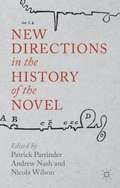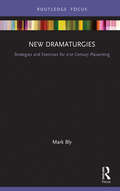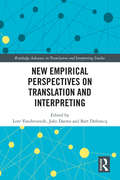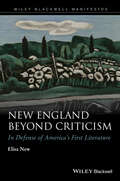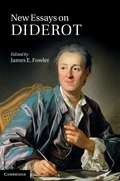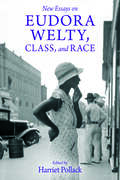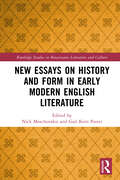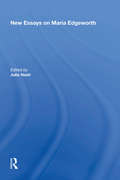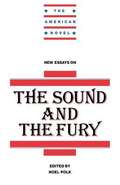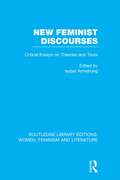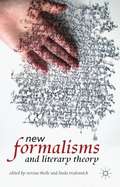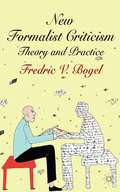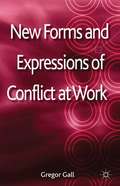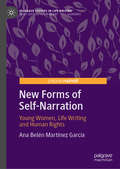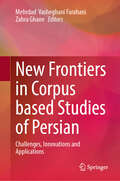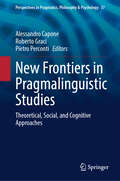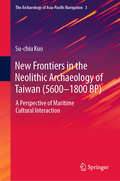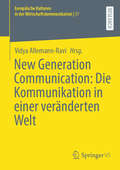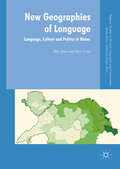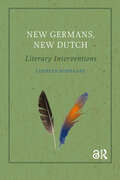- Table View
- List View
New Directions in the History of the Novel
by Patrick Parrinder Andrew Nash Nicola WilsonWhat exactly, and when, was the 'rise' of the novel? Is its dominance now over? How have material conditions, habits of reading, and authors' reactions to the changing international marketplace helped to shape the novel as a form? In a series of studies of British, American and postcolonial fiction from the 17th to the 21st century, New Directions in the History of the Novel challenges conventional accounts and sets out new areas for teaching and research. It includes separate sections on 'The Material Text', 'Questions of Realism and Form', 'The Novel in National and Transnational Cultures', and 'The Novel Now'. With contributions from leading scholars of the novel, this stimulating collection is required reading for teachers and students of the novel and its history.
New Dramaturgies: Strategies and Exercises for 21st Century Playwriting (Focus on Dramaturgy)
by Mark BlyIn New Dramaturgies: Strategies and Exercises for 21st Century Playwriting, Mark Bly offers a new playwriting book with nine unique play-generating exercises. These exercises offer dramaturgical strategies and tools for confronting and overcoming obstacles that all playwrights face. Each of the chapters features lively commentary and participation from Bly’s former students. They are now acclaimed writers and producers for media such as House of Cards, Weeds, Friday Night Lights, Warrior, and The Affair, and their plays appear onstage in major venues such as the Roundabout Theatre, Yale Rep, and the Royal National Theatre. They share thoughts about their original response to an exercise and why it continues to have a major impact on their writing and mentoring today. Each chapter concludes with their original, inventive, and provocative scene generated in response to Bly’s exercise, providing a vivid real-life example of what the exercises can create. Suitable for both students of playwriting and screenwriting, as well as professionals in the field, New Dramaturgies gives readers a rare combination of practical provocation and creative discussion.
New Empirical Perspectives on Translation and Interpreting (Routledge Advances in Translation and Interpreting Studies)
by Bart Defrancq Lore Vandevoorde Joke DaemsDrawing on work from both eminent and emerging scholars in translation and interpreting studies, this collection offers a critical reflection on current methodological practices in these fields toward strengthening the theoretical and empirical ties between them. Methodological and technological advances have pushed these respective areas of study forward in the last few decades, but advanced tools, such as eye tracking and keystroke logging, and insights from their use have often remained in isolation and not shared across disciplines. This volume explores empirical and theoretical challenges across these areas and the subsequent methodologies implemented to address them and how they might be mutually applied across translation and interpreting studies but also brought together toward a coherent empirical theory of translation and interpreting studies. Organized around three key themes—target-text orientedness, source-text orientedness, and translator/interpreter-orientedness—the book takes stock of both studies of translation and interpreting corpora and processes in an effort to answer such key questions, including: how do written translation and interpreting relate to each other? How do technological advances in these fields shape process and product? What would an empirical theory of translation and interpreting studies look like? Taken together, the collection showcases the possibilities of further dialogue around methodological practices in translation and interpreting studies and will be of interest to students and scholars in these fields.
New England Beyond Criticism: In Defense of America's First Literature (Wiley-Blackwell Manifestos)
by Elisa NewTimely and beautifully written, New England Beyond Criticism provides a passionate defense of the importance of the literature of New England to the American literary canon, and its impact on the development of spirituality, community, and culture in America. An exploration and defense of the prominence of New England’s literary tradition within the canon of American literature Traces the impact of the literature of New England on the development of spirituality, community, and culture in America Includes in-depth studies of work from authors and poets such as William Bradford, Emily Dickinson, Robert Frost, Henry David Thoreau, Susan Howe, and Marilynne Robinson Examines the place and impression of New England literature in the nation’s intellectual history and the lives of its readers
New Essays on Diderot
by James FowlerThe great eighteenth-century French thinker Denis Diderot (1713-1784) once compared himself to a weathervane, by which he meant that his mind was in constant motion. In an extraordinarily diverse career he produced novels, plays, art criticism, works of philosophy and poetics, and also reflected on music and opera. Perhaps most famously, he ensured the publication of the Encyclopédie, which has often been credited with hastening the onset of the French Revolution. Known as one of the three greatest philosophes of the Enlightenment, Diderot rejected the Christian ideas in which he had been raised. Instead, he became an atheist and a determinist. His radical questioning of received ideas and established religion led to a brief imprisonment, and for that reason, no doubt, some of his subsequent works were written for posterity. This collection of essays celebrates the life and work of this extraordinary figure as we approach the tercentenary of his birth.
New Essays on Eudora Welty, Class, and Race (Critical Perspectives on Eudora Welty)
by Harriet PollackContributions by Jacob Agner, Susan V. Donaldson, Sarah Gilbreath Ford, Stephen M. Fuller, Jean C. Griffith, Ebony Lumumba, Rebecca Mark, Donnie McMahand, Kevin Murphy, Harriet Pollack, Christin Marie Taylor, Annette Trefzer, and Adrienne Akins Warfield The year 2013 saw the publication of Eudora Welty, Whiteness, and Race, a collection in which twelve critics changed the conversation on Welty’s fiction and photography by mining and deciphering the complexity of her responses to the Jim Crow South. The thirteen diverse voices in New Essays on Eudora Welty, Class, and Race deepen, reflect on, and respond to those seminal discussions. These essays freshly consider such topics as Welty’s uses of African American signifying in her short stories and her attention to public street performances interacting with Jim Crow rules in her unpublished photographs. Contributors discuss her adaptations of gothic plots, haunted houses, Civil War stories, and film noir. And they frame Welty’s work with such subjects as Bob Dylan’s songwriting, the idea and history of the orphan in America, and standup comedy. They compare her handling of whiteness and race to other works by such contemporary writers as William Faulkner, Richard Wright, Toni Morrison, Chester Himes, and Alice Walker. Discussions of race and class here also bring her masterwork The Golden Apples and her novel Losing Battles, underrepresented in earlier conversations, into new focus. Moreover, as a group these essays provide insight into Welty as an innovative craftswoman and modernist technician, busily altering literary form with her frequent, pointed makeovers of familiar story patterns, plots, and genres.
New Essays on History and Form in Early Modern English Literature (Routledge Studies in Renaissance Literature and Culture)
by Nick Moschovakis Gail Kern PasterThis volume convenes eight noted scholars with varied positions at the interface of formal and historical literary criticism. The editors’ introduction—a far-reaching account of how both methods have intersected in studies of early modern English texts since the 1990s—is the first such survey in more than 15 years, making it invaluable to scholars entering this area. Three essays address foundational questions about genre, fictionality, and formlessness; five feature close readings of texts or passages ranging from the more canonical (Shakespeare, Herbert, Milton) to the less so (an official record of the 1604 Hampton Court Conference). For scholars and students alike, the book thus models a variety of ways both to conceptualize and to analyze the value of literature at the formal–historical interface. Encompassing drama, lyric, satirical and polemical prose, and metrical as well as rhetorical and logical forms, the collection closes with an afterword by theorist Caroline Levine.
New Essays on John Clare
by Kövesi, Simon and McEathron, Scott Simon Kövesi Scott MceathronJohn Clare (1793–1864) has long been recognized as one of England's foremost poets of nature, landscape and rural life. Scholars and general readers alike regard his tremendous creative output as a testament to a probing and powerful intellect. Clare was that rare amalgam ‒ a poet who wrote from a working-class, impoverished background, who was steeped in folk and ballad culture, and who yet, against all social expectations and prejudices, read and wrote himself into a grand literary tradition. All the while he maintained a determined sense of his own commitments to the poor, to natural history and to the local. Through the diverse approaches of ten scholars, this collection shows how Clare's many angles of critical vision illuminate current understandings of environmental ethics, aesthetics, Romantic and Victorian literary history, and the nature of work.
New Essays on Maria Edgeworth (The\nineteenth Century Ser.)
by Julie NashDevoted to the varied writings of the influential novelist, children's author, and educator, this collection situates Edgeworth's writing in the context of her life and times. Combining postcolonial, historical, and gender criticism, the contributors offer fresh readings of Edgeworth's novels, stories, letters, and educational texts, including Belinda, Moral Tales, Practical Education, Helen, and The Absentee. Throughout her work, Edgeworth confronts a world whose values, while grounded in tradition and supported by slavery and colonial domination, are being challenged and ultimately changed in surprising ways by women, peasants, servants, and other voices from the margins. In discussing Edgeworth and her writing, the contributors also offer innovative perspectives on the novel and other central issues of eighteenth- and nineteenth-century literature. The collection will be invaluable to established scholars working in eighteenth- and nineteenth-century literature, women's studies, and children's literature, as well as to students encountering Edgeworth for the first time.
New Essays on the Sound and the Fury
by Noel PolkWilliam Faulkner's The Sound and the Fury met with only limited success when published in 1929, probably due to its fragmented, non-chronological structure. Since, however, it has become one of the most popular of Faulkner's novels serving as a litmus paper upon which critical approaches have tested themselves. In the introduction to this volume Noel Polk (the editor) traces the critical responses to the novel from the time of its publication to the present day. The essays that follow present contemporary reassessments of The Sound and the Fury from a variety of critical perspectives. Dawn Trouard offers us the women of The Sound and the Fury, reading against the grain of the predominant critical tradition which sees the women through the lens of masculine cultural biases. Donald M. Kartiganer comes to terms with the ways in which the novel simultaneously attracts readers and resists readings. Richard Godden discusses the relationship between incest and miscegenation. Noel Polk examines closely the way Faulkner experiments with language.
New Feminist Discourses: Critical Essays on Theories and Texts (Routledge Library Editions: Women, Feminism and Literature)
by Isobel ArmstrongThis collection of new feminist essays represents the work of young critics researching and teaching in British Universities. Aiming to set the agenda for feminist criticism in the nineties, the essays debate themes crucial to the development of feminist thought: among them, the problems of gendered knowledge and the implications of accounts of gendered language, cultural restraints on the representation of sexuality, women’s agency, cultural and political change, a feminist aesthetics and new readings of race and class. This variety is given coherence by a unity of aim – to forge new feminist discourses by addressing conceptual and cultural questions central to problems of gender and sexual difference. The topics of discussion range from matrilinear thought to seventeenth-century prophecy; the poetry of Amelia Lanyer to Julia Margaret Cameron’s photographs; from Dorothy Richardson and Virginia Woolf to eighteenth-century colonial painting of the South Pacific; from medieval romance to feminist epistemology. The essays utilise and question the disciplines of literary criticism, art history, photography, psychoanalysis, Marxist history and post-structuralist theory.
New Formalisms and Literary Theory
by Verena Theile Linda TredennickBringing together scholars who have critically followed New Formalism's journey through time, space, and learning environment, this collection of essays both solidifies and consolidates New Formalism as a burgeoning field of literary criticism and explicates its potential as a varied but viable methodology of contemporary critical theory.
New Formalist Criticism
by Fredric V. BogelNew Formalist Criticism defines and theorizes a mode of formalist criticism that is theoretically compatible with current thinking about literature and theory. New formalism anticipates a move in literary studies back towards the text and, in so doing, establishes itself as one of the most exciting areas of contemporary critical theory.
New Forms and Expressions of Conflict at Work
by Gregor GallA survey and analysis of the new forms and expressions of conflict at work under capitalism. This collection uses theoretical and empirical approaches to demonstrate that there is an underlying historical continuity to current and new forms and expressions of conflict at work and that there is also a path dependency by country and culture. Although the strike is in decline in many countries, it is not so in all and different means of expressing and resolving collective grievances are used but not always as substitutes to the weapon of strike.
New Forms of Self-Narration: Young Women, Life Writing and Human Rights (Palgrave Studies in Life Writing)
by Ana Belén Martínez GarcíaThis book is a timely study of young women’s life writing as a form of human rights activism. It focuses on six young women who suffered human rights violations when they were girls and have gone on to become activists through life writing: Malala Yousafzai, Hyeonseo Lee, Yeonmi Park, Bana Alabed, Nujeen Mustafa, and Nadia Murad. Their ongoing life-writing projects diverge to some extent, but all share several notable features: they claim a testimonial collective voice, they deploy rights discourse, they excite humanitarian emotions, they link up their context-bound plight with bigger social justice causes, and they use English as their vehicle of self-expression and self-construction. This strategic use of English is of vital importance, as it has brought them together as icons in the public sphere within the last six years. New Forms of Self-Narration is the first ever attempt to explore all these activists’ life-writing texts side by side, encompassing both the written and the audiovisual material, online and offline, and taking all texts as belonging to a unique, single, though multifaceted, project.
New Friends Workbook (Grade #3)
by Pathway PublishersThis workbook has been prepared especially for third graders in Amish Parochial schools, to accompany the grade three reader, New Friends. The exercises were designed to train the children to work independently, with a minimum of teacher assistance. The teacher will find tests in the back of this workbook.
New Frontiers in Corpus Based Studies of Persian: Challenges, Innovations and Applications
by Mehrdad Vasheghani Farahani Zahra GhaneIn the rapidly evolving field of language studies, this book offers a groundbreaking application of Corpus Linguistics to Persian—a language that has long been underrepresented in corpus-based research. Through a systematic analysis of linguistic data, the work explores the structural and functional dimensions of Persian, uncovering key trends in grammar, lexical usage, and sociolinguistic variation. By employing corpus-driven methodologies, it sheds light on the dynamic evolution of the language, providing deep insights into both contemporary usage and historical change. This book serves as a valuable resource for researchers and linguists with a designated interest in the application of Corpus Linguistics to Persian. It runs the gamut from syntax and semantics to digital humanities and translation studies, offering both depth and breadth in linguistic inquiry. By addressing a significant gap in the Persian language research, the edited volume comes to offer a fresh perspective on how corpus-based approaches can illuminate the dynamic nature of language and broaden our understanding of its use across contexts.
New Frontiers in Language and Technology (Elements in Applied Linguistics)
by Christopher Joseph JenksThe Fourth Industrial Revolution (4IR) describes the technological transformations that are incrementally, but radically, changing everyday life practices. Like previous industrial revolutions, technological advancements are so pervasive and impactful that everything from an individual's sense of identity and understanding of the world to the economic success of an entire industry are profoundly altered by 4IR innovation. Despite the significance of 4IR transformations, little applied linguistic research has examined how these emergent technologies collectively transform human behavior and communication. To this end, this Element identifies key 4IR issues and outlines how they relate to applied linguistic research. The Element argues that applied linguists are in an excellent position to contribute to such research, as expertise in language and communication is critical to understanding 4IR issues. However, to make interdisciplinary and wider societal contributions, applied linguists must rethink how 4IR technologies can be harnessed to more efficiently publish and disseminate timely research.
New Frontiers in Pragmalinguistic Studies: Theoretical, Social, and Cognitive Approaches (Perspectives in Pragmatics, Philosophy & Psychology #37)
by Alessandro Capone Pietro Perconti Roberto GraciThis book contains a comprehensive view of pragmalinguistic studies and their recent ramifications, boasting some of the most advanced recent research in pragmatics. Organised into three sections—pragmalinguistics, social pragmatics, and cognitive-inferential pragmatics, respectively—the chapters enable an understanding of the possible applications of linguistic and philosophical theories in practical fields. Covering topics such as polysemy across languages and lexical externalism, the role of literal meaning in the construction of metaphorical meaning, the pragmatics of truth, the roles of reflexivity in meaning negotiation, argumentation and discourse, the pragmatics of taboo, linguistic and cognitive aspects of formation of implicates, and reflections on neuropragmatics and clinical pragmatics in Autism Spectrum Disorder and Schizophrenia—to name but a few exciting areas of exploration—this book is of interest to scholars and postgraduate students in the fields of semantics, pragmatics and philosophy of language, cognitive science, and other areas of linguistics.
New Frontiers in the Neolithic Archaeology of Taiwan: A Perspective of Maritime Cultural Interaction (The Archaeology of Asia-Pacific Navigation #3)
by Su-chiu KuoThis book summarizes the systematic research on the Neolithic cultures of Taiwan, based on the latest archaeological discoveries, and focusing on the maritime interactions between mainland southeast China, Taiwan, and southeast Asia during (5600-1800 BP). The study demonstrates and sheds light on the distinctiveness of Taiwan’s Neolithic cultures, their interactions with the external cultures of its surrounding regions, the maritime cultural diffusion and early seafaring across sea regions like the Taiwan Strait, Bashi channel and South China Sea. Drawing on the author’s deep understanding of Taiwan and its surrounding regions, the book also incorporates recent archeological findings by Taiwanese researchers. Further, based on a new reconstruction of the spatiotemporal framework of Taiwanese prehistoric cultures, the chronologically arranged chapters discuss Neolithic cultures of the early, middle, late and final stage of this island region, revealing the prehistoric cultural development, regional typology and their maritime interactions with surrounding regions. The typological study of the native traits and external cultural influences of each stage of Neolithic culture shows the prehistoric and early history of this key stepping stone in the Asia-Pacific region.
New Generation Communication: Die Kommunikation in einer veränderten Welt (Europäische Kulturen in der Wirtschaftskommunikation #37)
by Vidya Allemann-RaviCommunication of the new generation is upon us. It was not long ago that the idea of remote working or of machine learning seemed like futuristic endeavors. Yet now, the prospect of using various communication technologies to work for us has never been more feasible. We are navigating connected ecosystems and using data technologies and algorithms to keep pace with an ever-shifting business world. This volume focuses on the impact of communication in a changing world on society and business cultures. The issues that are raised by the authors of this volume range from exploring how language and technology interact in the workplace environment to considering the use of generative technologies and artificial intelligence in marketing and advertising. While the authors showcase a diversity of disciplinary and methodological approaches, they are united in their underlying belief that communication in a changing world is, by and large, a facilitator of dialogue, and is powered by interactions and expansive, cross-disciplinary conversations.
New Geographies of Language: Language, Culture and Politics in Wales (Palgrave Studies in Minority Languages and Communities)
by Rhys Jones Huw LewisThis book develops a novel approach to the study of language, bringing it into dialogue with the latest geographical concepts and concerns and provides a comprehensive account of the geography of Welsh language analysing policy development, language use, ability and shift. The authors examine in particular: the different ways in which languages can be mapped; how geographical insights can be used to develop understandings of language use; the value of assemblage theory as a way of interpreting the social, technical and spatial aspects of language policy development; and the geographies that characterise institutional engagements with languages. This book will set a research agenda for the geographical study of language, developing a conceptual framework that will offer fresh insights to researchers in the fields of Applied Linguistics, Sociolinguistics, Minority Languages, Geolinguistics, and Public Policy.
New Germans, New Dutch: Literary Interventions (Palimpsest: Disorientations)
by Liesbeth MinnaardIn the globalised world of today, traditional definitions of national Self and national Other no longer hold. The unmistakable transformation of German and Dutch societies demands a thorough rethinking of national boundaries on several levels. This book examines how literature of migration intervenes in public discourses on multiculturality in Germany and the Netherlands, epitomised in the strikingly parallel debates on the ‘German Leitkultur’ and the Dutch ‘multicultural drama’ in the year 2000. By juxtaposing detailed analyses of literary work by the Turkish-German writers Emine Sevgi Özdamar and Feridun Zaimoglu and the Moroccan-Dutch writers Abdelkader Benali and Hafid Bouazza, New Germans, New Dutch offers crucial insights into the specific ways in which this literature negotiates its national context of writing. This book demonstrates how German literature of migration seeks alternative forms of community outside the national parameters, whereas the Dutch literature negotiates difference and re-imagines Dutchness within the national framework.
New Heroes in Antiquity: From Achilles to Antinoos (Revealing Antiquity #18)
by Christopher P. JonesHeroes and heroines in antiquity inhabited a space somewhere between gods and humans. In this detailed, yet brilliantly wide-ranging analysis, Christopher Jones starts from literary heroes such as Achilles and moves to the historical record of those exceptional men and women who were worshiped after death. He asks why and how mortals were heroized, and what exactly becoming a hero entailed in terms of religious action and belief. He proves that the growing popularity of heroizing the dead—fallen warriors, family members, magnanimous citizens—represents not a decline from earlier practice but an adaptation to new contexts and modes of thought. The most famous example of this process is Hadrian’s beloved, Antinoos, who can now be located within an ancient tradition of heroizing extraordinary youths who died prematurely. This book, wholly new and beautifully written, rescues the hero from literary metaphor and vividly restores heroism to the reality of ancient life.
